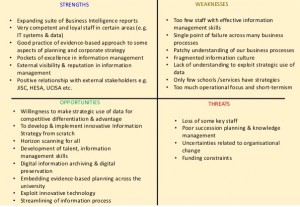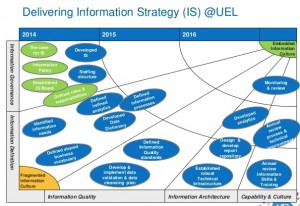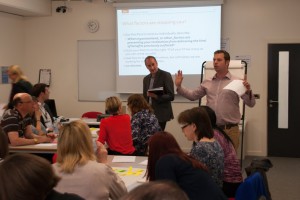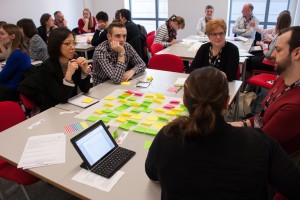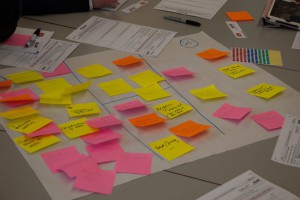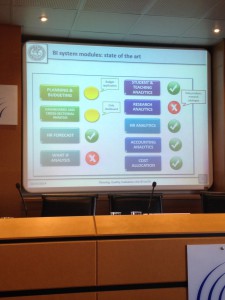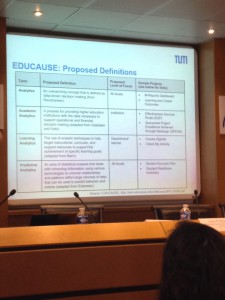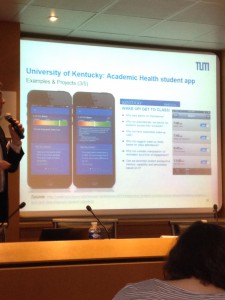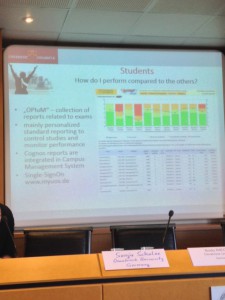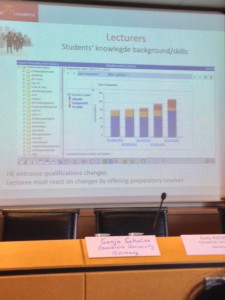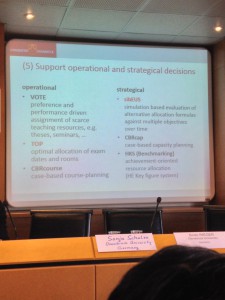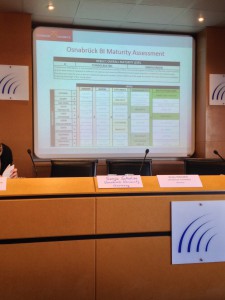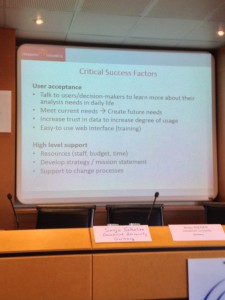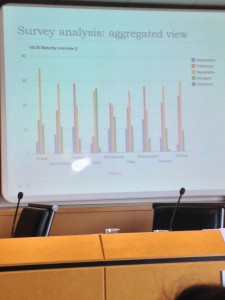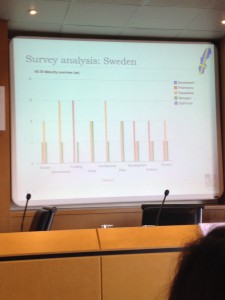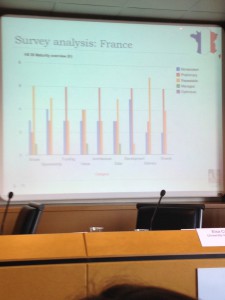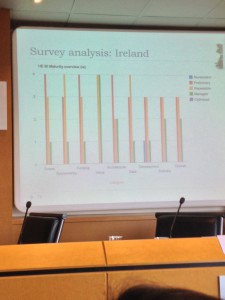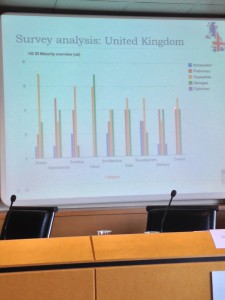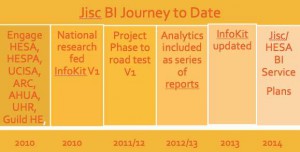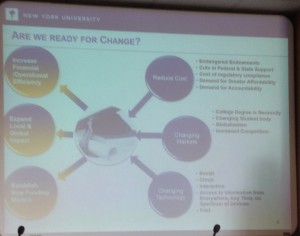31 July 2014 finds me at a Jisc RSC hosted event exploring Information Strategies and associated issues for the HE and FE sector. Hosted by UEL and arranged by Martin Sepion and Julian Bream of Jisc RSC London.
I’m joining a diverse set of people from Enterprise Architect, Data Architect, Heads of Enterprise Solutions, Chief Information Officer and that ilk. I’m presenting a session on our Jisc / HESA Business Intelligence project later this morning. My own aims are to raise awareness of the initiative and gather feedback on the sorts of issues people need to address in order to design and implement an Information Strategy and what linkages there may be to the proposed National BI Service Jisc are developing with HESA and HESPA.
Feels like I’m in the right room.
Martin Sepion (Jisc RSC London)
Jisc RSC London have been working with UEl on developing and implementing an Information Strategy.
Martin described a common scenario of data flow throughout an education provider and how this might be optimised. This throws up a significant number of barriers with procurement being a key issue along with many others such as staff skills, vision and strategy (collective).
How do you know whether your information systems are doing a good job? A self assessment process was designed which sounds very much like a variation on the Jisc Strategic ICT Toolit. (LINK) I’ll chase down a link to this.
Gordon Millner (RSC East Midlands) described a data strategy template that has been developed and made available. He also touched don Dashboards, Visualisations and Big Data as issues and opportunities.
Me, Teresa, Jisc/HESA BI Service Initiative
Our slides are here. The session went well. The show of hands for BI definition fell heavenly between Gartner (top down) and Microsoft (bottom up). The Jisc definition failed to attract as single vote so one for us to revisit! We showed the Liverpool University Business Intelligence Case Study Video (a previous Jisc funded project) on YouTube (LINK). I asked the question – who has this capability? The answer was no one but UEL (also a previous Jisc funded BI project). This really backs up the notion of the Jisc/HESA BI Service offering a ‘leg up’ to those with little capability and the opportunity to gather momentum and evidence toward a business case for investment.
I asked the question ‘who here would like to have the Liverpool capability’. The answer not surprisingly was everyone.
Teresa and I posed 5 questions we’re seeking the answers to and will be gathering input on this later in the day;
1. In relation to your current role what is the most burning question that you would like to be able to answer which you are not currently able to? In short: What would you most like to know?
2. Why do you feel you are currently unable to answer the question you outlined above?
3. From your point of view, who in your organisation would be interested in having access to BI information?
4. Thinking about BI systems in your institution, where would you place it right now on a scale from 1 to 10?
5. We are planning to run a survey on maturity of BI systems in organisations. Would you be interested in participating, or know someone who would?
6. What sorts of services should the Heidi Plus offer
to move people along with BI agenda?
We compiled a list of likely responses to the discussions planned later, namely what issues will need to be solved in implementing an Information Strategy (and hence capability to develop and benefit from BI RE question 6 above). These could form the basis the sorts of services needed within the Jisc/HESA BI Project and repeat these below;
Strategy development and the technological enablers to allow implementation
Records and information management
Data quality assurance
Data governance
Master data management
Vendor selection and purchasing
Developing good data visualisations
Non-technological enablers to for strategy implementation;
To ensure dashboard data is embedded into institutional processes
Andy Cook (CIO UEL) and Gurdish Sandhu (UEL)
This presentation describes the UEL journey of Information Strategy design and implementation and is worthy of a look through. Here’s the presentation. Pay attention to the SWOT and the issues and timescales repeated below.
Several key points to this, the ones that struck me were on staff skills (and presumably culture) so linkages to Jisc ‘Digital literacies’, single point of truth (data warehousing / data cleansing) linked to key people (improve data quality by assigning ownership – Information Asset Owners, Information Asset Managers, Data Stewards), concentrating on key business areas and systems (research, finance, student, staff etc), proliferation of small Access / Excel databases (Andy has removed Access training for staff) noting people do this because corporate systems don’t meet their needs.
Group discussion findings
The groups were tasked with discussing related issues from what they’d heard today and based on the two key slides SWOT analysis and Delivering IS.
Here are the headline areas (ideal for a mapping to Jisc resources and a gap analysis)
1. How people use the data provided – skills and culture change
Attendee tips; self assessment based on KPIs via monthly management group meetings
Jisc resources; Digital Literacies InfoKit, Organisational Change InfoKit, Data Visualisation InfoKit
2. Embedding Information Culture, establishing a business case for a large investment, KPIs for the improvements BI brings
Attendee tips; aligning business acumen on enhancing institutional performance with key data literate people
Jisc resources; Business Intelligence InfoKit (building a business case)
3. Data Quality and how to assess how advanced this is in an institution
4. Siloed manual intensive data and reporting. Culture shift, top level buy in.
Jisc resources;
5. Master data and technical issues to assist the strategy implementation. Includes enabling technologies such as good wifi
6. Role of Enterprise Architecture in optimising and controlling the underlying systems required to promote Information Strategy implementation
7. Good information and records management as an iterative process that must be embedded as a cyclical exercise not a one off
8. Ambitious strategy to include organisational and external data but being realistic on time scale to help encourage a vision of what good information use can achieve
9. Cleaning up all the data, or just the bits you need
10. Analytics skills as reality – BI can be a big part of the solution and the problem – introducing a level of complexity that magnifies the problems of data literacy and the interpretation burden on other staff
11. Doing something of value in a short time period – moving to action to demonstrate opportunity and value, examples of what can be achieved to drive momentum, support and investment
12. Top down support to provide authority and break log jams impenetrable by those building the systems
13. Trying to do it all is akin to boiling the ocean, small steps to achieve highly visible impact could be helpful
14. It’s all about the value and the benefit and how to report that back to the business – high profile wins need to be celebrated in a visible manner. It’s not about providing the technology or bombarding people with information and systems that don;t meet end user needs. Top table guidance is important. Bottom up approach isn’t enough.
Last note from me – the organisers added their own report of the day here

